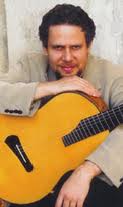|
Recital
ELEGANT VOCAL MASTERY AT ROSES SIGNATURE RECITAL
by Pamela Hicks Gailey
Sunday, February 25, 2024
Recital
DEMANDING SCHUMANN WORK IN MUSIC AT OAKMONT RECITAL
by Terry McNeill
Thursday, November 9, 2023
Recital
RARE RAVEL IN MENDO FESTIVAL'S PRESTON HALL
by Terry McNeill
Thursday, July 20, 2023
Recital
FRENCH FLAVOR IN RARE FOUR-HAND RECITAL
by Judy Walker
Sunday, January 15, 2023
Recital
ASSERTIVE PIANISM IN YAKUSHEV'S OCCIDENTAL RECITAL
by Terry McNeill
Sunday, November 13, 2022
Recital
HEROIC LIM PERFORMANCE AT STEINWAY SOCIETY RECITAL
by Abby Wasserman
Sunday, September 18, 2022
Recital
AGGRESSIVE PIANISM IN MYER'S MENDO FESTIVAL RECITAL
by Terry McNeill
Thursday, July 14, 2022
Recital
UNIQUE ELEGANCE IN GALBRAITH GUITAR RECITAL
by Gary Digman
Friday, April 29, 2022
Recital
ALLURING GLASS WORKS IN WEILL RECITAL
by Terry McNeill
Friday, March 25, 2022
Recital
FORGOTTEN BACH SHINES IN YARDEN'S OAKMONT RECITAL
by Terry McNeill
Thursday, March 10, 2022
|
 |
 Guitarist Adam Del Monte |
DEL MONTE'S GUITAR COMPOSITIONS MORE JAZZ THAN FLAMENCO AT SSU RECITAL
by Robin Brown
Friday, November 11, 2011
Substituting for classical guitarist William Kanengiser, guitarist Adam Del Monte played his own compositions and promised a Tárrega solo November 11 at a Sonoma State University recital in Green Music Center 1028.
Mr. del Monte’s playing was characterized by zippy scales and an adjusted instrument with some low strings tuned down. Low tunings are critical for the modest voice of the guitar. Unfortunately, Mr. Del Monte’s compositions lacked cohesive form and lucid textures, and sounded like demonstrating technique for technique’s sake. He is a fused cool-jazz stylist, particularly when stroking the occasional fuzzy tuned down bass strings, but there is no flamenco bite attack to effectively carry a dance tune in a jazz style.
Mr. Del Monte performed on a light colored shallow-body flamenco guitar that had an adequate voice when played with a Paco de Lucía modern flourish. He balanced the guitar high-style on the right thigh with the butt roughly below the tie-bridge. The guitarist's upper arm rests on the upper side to press down onto the leg like a vice, a precarious balance and tiring in long rehearsals. High-style allows a dance accompanist a higher sight-line and it might relieve left hand tension better than does the Andrés Segovia classical guitar position. A few flamenco players use this position and also use a footstool.
Mr. Del Monte has performed in this area before, in Healdsburg’s Ravel Cinema, where he accompanied dancers and played solo works. In this recital his playing has changed with a more facile picado alteration of index and middle fingers for scales. Before playing his Tango closer of the first half, he spoke at length of comparing forms in flamenco musical culture. In addition to the talk being confusing, there were errors on some origins of flamenco. The closest he got to any traditional flamenco toque instrumental form was the Allegro mood of his study piece subtitled Alegria. But here the playing lacked exciting shifts in dance stresses and any feeling of Lento contrast. There was little juxtaposing of parallel major to minor to major melodies and the overall dance-song feeling was absent. A typical alegría of Cádiz has danceable stress patterns but Mr. Del Monte’s composition lacked the typical hemiola doce medidas rhythmic stress pattern.
So, it was a confusing mix of explanation and performance. But in a tablao nightclub in Spain, one generally hears one fast solo and modern guitar accompaniment to composed texts for modern flamenco dance. This recital wasn’t flamenco.
|
